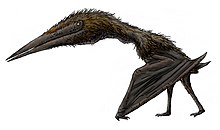Aerotitan
| Aerotitan Temporal range: Maastrichtian
~ | |
|---|---|

| |
| Restoration of Aerotitan as an azhdarchid, following the original interpretation | |
| Scientific classification | |
| Kingdom: | Animalia |
| Phylum: | Chordata |
| Order: | †Pterosauria |
| Suborder: | †Pterodactyloidea |
| Family: | †Azhdarchidae |
| Genus: | †Aerotitan Novas et al. 2012 |
| Species: | †A. sudamericanus
|
| Binomial name | |
| †Aerotitan sudamericanus Novas et al. 2012
| |
Aerotitan is a genus of large azhdarchid pterosaur known from the Late Cretaceous period (Maastrichtian stage) of what is now the Allen Formation of the Neuquén Basin in northern Patagonia, Argentina.[1]
Discovery and naming[]
The type species Aerotitan sudamericanus was named and described in 2012 by Fernando Novas, , , Martin Ezcurra, , , and . The generic name is derived from Greek ἀήρ, aer, "air", and Titan, in reference to the fact the species represents a large flying reptile. The specific name refers to its provenance from South America.[1]
The holotype, MPCN-PV 0054, has been recovered near the site, in Patagonia, from a layer of the upper Allen Formation. It consists, according to the original description, of a partial rostrum with a preserved length of 264 millimeters (10.4 in). This snout is elongated and transversely compressed and the jaws are toothless. The wingspan has been estimated as at least 5 meters (16 ft).[1]
In 2021, a study concluded that the specimen represented, not the upper jaws but the lower jaws.[2]
Taxonomy[]
Aerotitan has been assigned to the Azhdarchidae. If correct, this would make it the first unambiguous azhdarchid from South America.[1] A study published by Nicholas Longrich and colleagues in 2018 classified the genus as a thalassodromid, sister taxon to Alanqa (a pterosaur also assigned as an azhdarchid), however, such assignment is not well-supported.[3] The cladogram of their analysis is presented below:
| Dsungaripteromorpha |
| ||||||||||||||||||||||||||||||
Conversely, a 2021 study by Rodrigo Pêgas and colleagues noted dissimilarities between it and thalassodromines and supported an azhdarchid identity.[2]
See also[]
References[]
- ^ a b c d Novas, F. E.; Kundrát, M.; Agnolín, F. L.; Ezcurra, M. D.; Ahlberg, P. E.; Iasi, M. P.; Arriagada, A.; Chafrat, P. (2012). "A New Large Pterosaur from the Late Cretaceous of Patagonia". Journal of Vertebrate Paleontology. 32 (6): 1447–1452. doi:10.1080/02724634.2012.703979. JSTOR 23361061. S2CID 84340520.
- ^ a b Pêgas, R.V.; Holgado, B.; Ortiz David, L.D.; Baiano, M.A.; Costa, F.R. (August 21, 2021). "On the pterosaur Aerotitan sudamericanus (Neuquén Basin, Upper Cretaceous of Argentina), with comments on azhdarchoid phylogeny and jaw anatomy". Cretaceous Research. 129: Article 104998. doi:10.1016/j.cretres.2021.104998. ISSN 0195-6671. S2CID 238725853.
- ^ Longrich, Nicholas R.; Martill, David M.; Andres, Brian (2018). "Late Maastrichtian pterosaurs from North Africa and mass extinction of Pterosauria at the Cretaceous-Paleogene boundary". PLOS Biology. 16 (3): e2001663. doi:10.1371/journal.pbio.2001663. PMC 5849296. PMID 29534059.
- Azhdarchids
- Maastrichtian life
- Late Cretaceous pterosaurs of South America
- Cretaceous Argentina
- Fossils of Argentina
- Allen Formation
- Fossil taxa described in 2012
- Taxa named by Fernando Novas












